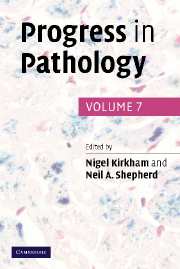Book contents
- Frontmatter
- Contents
- List of Contributors
- Preface
- 1 The microbiological investigation of sudden unexpected death in infancy
- 2 An overview of childhood lymphomas
- 3 Assessment of the brain in the hospital consented autopsy
- 4 The value of immunohistochemistry as a diagnostic aid in gynaecological pathology
- 5 The role of the pathologist in the diagnosis of cardiomyopathy: a personal view
- 6 Metastatic adenocarcinoma of unknown origin
- 7 Immune responses to tumours: current concepts and applications
- 8 Post-mortem imaging – an update
- 9 Understanding the Human Tissue Act 2004
- 10 The Multidisciplinary Team (MDT) meeting and the role of pathology
- 11 Drug induced liver injury
- Index
- References
7 - Immune responses to tumours: current concepts and applications
Published online by Cambridge University Press: 06 January 2010
- Frontmatter
- Contents
- List of Contributors
- Preface
- 1 The microbiological investigation of sudden unexpected death in infancy
- 2 An overview of childhood lymphomas
- 3 Assessment of the brain in the hospital consented autopsy
- 4 The value of immunohistochemistry as a diagnostic aid in gynaecological pathology
- 5 The role of the pathologist in the diagnosis of cardiomyopathy: a personal view
- 6 Metastatic adenocarcinoma of unknown origin
- 7 Immune responses to tumours: current concepts and applications
- 8 Post-mortem imaging – an update
- 9 Understanding the Human Tissue Act 2004
- 10 The Multidisciplinary Team (MDT) meeting and the role of pathology
- 11 Drug induced liver injury
- Index
- References
- Type
- Chapter
- Information
- Progress in Pathology , pp. 163 - 198Publisher: Cambridge University PressPrint publication year: 2007

